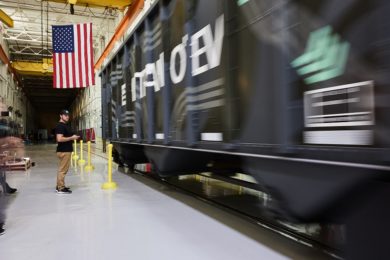DuPont Protection Technologies has completed field tests measuring DuPont™ Kevlar® use in mining conveyor belts. The results indicated that the use of DuPont increases productivity and reduced annual maintenance costs. Data collected in a field trial with the copper mining company, Codelco (National Copper Corporation of Chile) through Plants Management of the Andina Division, demonstrated a capacity increase of over 18% with a 60% reduction in annual maintenance costs.
William F Weber, Vice President, Kevlar, DuPont Protection Technologies said: “The lightweight strength, durability and performance of this advanced material in extreme conditions make it an ideal choice in this application. The belts can run faster with less wear and tear, enabling mining companies to break boundaries – to Dare Bigger™ in terms of their capacity.”
“In mining, conveyor belts must go down into the bowels of the earth. Copper ore is sharp and hard on equipment used to extract it,” said Patricio Porta, Analyst Specialist-Operations, Management of Plants, Codelco Andina Division. “The belts we have installed with DuPont Kevlar fiber are durable and strong; they make a great impact on our production.”
DuPont Kevlar fiber helps enable conveyor belt manufacturers to offer lighter, more flexible and longer life solutions to mining companies, increasing throughput and reducing operational costs associated with installation, maintenance, replacement and energy consumption. The advantage of lightweight, thin and strong belts using Kevlar include:
- Ease of installation – belts made with Kevlar fiber are easy to integrate into an existing setup because, unlike polyester/nylon or steel, belts made with Kevlar can go on almost any size pulley or system without reconfiguration.
Codelco Andina Division replaced a 48 m conveyor belt containing a 5 ply conventional nylon/polyester (EP) cord carcass made with a comparable belt containing a single-layer DuPont Kevlar Advanced Performance (AP) fiber.
- Productivity improvements – Belts made with Kevlar fiber are lighter and can run at higher speeds, are stronger and therefore help reduce maintenance downtime, and are more flexible so they allow a greater trough angle preventing materials from sliding off, even at higher speeds.
At Codelco Andina Division, throughput increased 3,000 t/d.
- Energy savings –Kevlar can offer tremendous cost savings in terms of decreased power consumption – DuPont has developed an energy calculator to help belt manufacturers and mining companies evaluate the benefits of adding Kevlar brand fiber for lower energy per ton of material conveyed.
- Reduced maintenance – Despite their flexibility, belts made of Kevlar fiber exhibit very low creep. Since they hardly stretch, once installed, belts containing Kevlar rarely require re-splicing, a process which typically consumes a whole day. This stability, combined with the toughness of Kevlar fiber, helps reduce maintenance outages to a bare minimum.
At Codelco Andina Division, maintenance was required only a third as often and the yearly maintenance cost dropped from $0.14/t to $0.055/t.
The versatility of the Kevlar technology platform helps enable customers to design products that make a difference when performance and safety are crucial. Kevlar is best known for its use in ballistic and stab-resistant body armor, but can be extended to a range of industries and applications.









